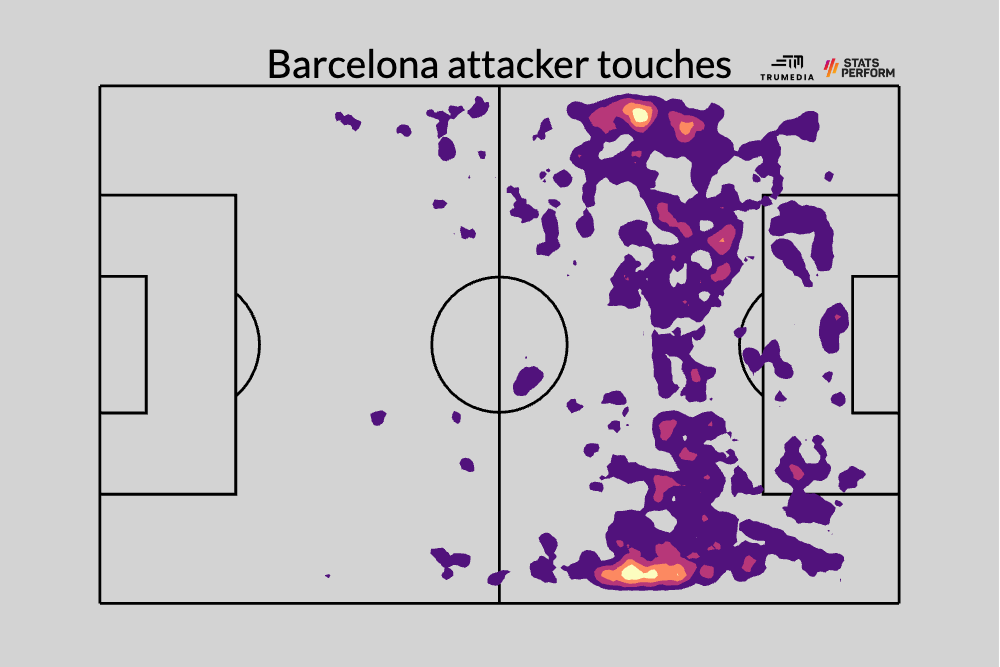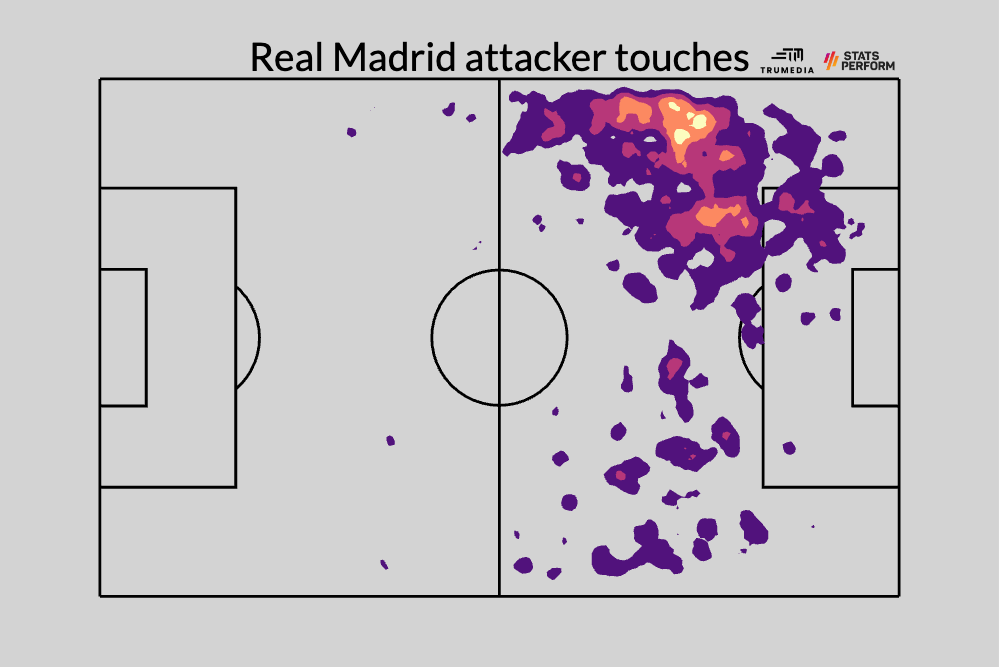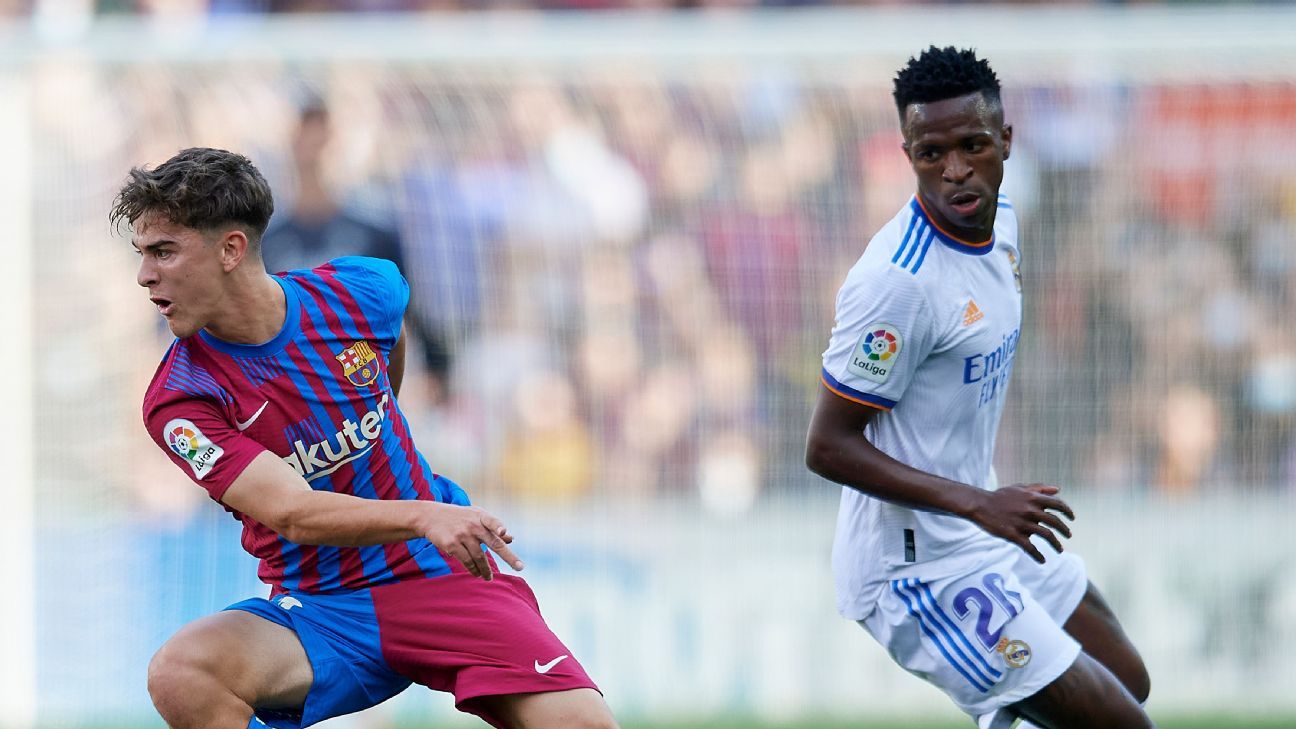It’s the biggest derby in soccer, maybe the biggest league match in the world, and it always feels like it’s played in a state of motion. You can’t just talk about Real Madrid and Barcelona as they are — El Clasico is forever about these storied clubs as they were and will be, too. (They face off Sunday, Oct. 16, 10:15 a.m. ET, on ESPN+.)
You can’t talk about Barcelona without referencing and weighing the wild spending spree they went on this summer. Despite having the best team in LaLiga over the second half of last season, despite stomping Real Madrid 4-0 in March and despite crippling debt issues that forced the departure of Lionel Messi last August, the club sold future television revenue and part of the club’s in-house production company to afford the acquisition of seven new players, only two of whom have yet become primary starters. (And because the Transfer Industrial Complex never pauses for even a second, there are already rumors of them trying to figure out how to bring Messi back next summer.)
Thanks to a pair of poor performances against Inter Milan, they are now staring elimination — and the deprivation of the money that comes with appearances in the Champions League knockout rounds — in the face. That colors everything we say about Barcelona in the process, too.
– Real Madrid vs. Barcelona on ESPN+ (Sunday, Oct. 16, 10:15 a.m. ET)
Meanwhile, you can’t talk about Real Madrid without referencing future Galacticos. A week’s worth of “Erling Haaland has a special release clause for Real Madrid?” headlines came out of nowhere last week, and after only a brief respite, the “Kylian Mbappe to Madrid?” rumors have started all over again. It seems it’s rarely about who Real Madrid has; it’s always about who they’re going to have.
That’s a shame because if we were to simply pause time and stay in the present tense, we’d be looking at what is, on paper, about as even a matchup as you could want for any match, much less the derby of all derbies. El Clasico kicks off in Madrid’s Estadio Santiago Bernabeu this Sunday, and it could be an absolute delight.
A rare level of early domestic dominance
Over the past seven seasons, Barca and Real Madrid have combined for six LaLiga titles and four Champions League titles, but between them they had only topped 18 points in their first eight matchdays once in that span (Barca did it in 2017-18 on the way to 93 points and an easy title). They have taken to easing into a given season.
This season, they both stand at 22 points after eight matches. Barca began the season with a 0-0 home draw against Rayo Vallecano, but have won its last seven matches by a combined 20-1. Real Madrid has already beaten third-place Atletico Madrid and fifth-place Real Betis, only dropping points in an unlucky 1-1 draw with Osasuna on Oct. 2.
The stats back up most of the form, too:
-
Barcelona are first in goals scored, goals allowed and xG generated and third in xG allowed. Real Madrid are second, fifth, second and second, respectively, in those categories. It’s as if they have the two best veteran strikers in the world or something. (Spoiler: They do.)
-
Real Madrid attempt the most shots per possession and allow the second-lowest xG per shot in defense; Barcelona average the highest xG per shot and allows the fewest shots per possession.
-
Barcelona take 73% of their matches’ overall touches in the defenders’ box, and Real Madrid take 67%; no one else in the league is over 61%.
-
Real Madrid have scored the second-most goals from set pieces (five). Barcelona have yet to allow any goals from set pieces.
The closest thing to a weakness either team has shown in the league thus far is Real Madrid’s passive defense: Los Blancos rank sixth in shots allowed per possession, and they rank 14th in allowing 12.8 passes per defensive action (PPDA, a common measure of defensive activity levels). Of course, luring opponents away from their own goal has also worked to make them just about the best counter-attacking team in Europe; even that supposed weakness comes with a strength.
Mastering the transition phase
There have been a number of statistical shifts from last season. Real Madrid is attempting a higher volume of shots, but at lower quality (and with only 39% of their shots coming from the defenders’ box), while their opponents are also attempting lower-quality shots on average. Barcelona is showing increased defensive energy, ranking second in PPDA and starting 10.6% of their possessions in the attacking third (also second). And if we’re being honest, Barca’s Marc-Andre ter Stegen has been saving shots at an unsustainably high rate: 96% to date. That average will come down even if Barca remains impeccably organized on defense and ter Stegen maintains the best form of his career. (Case in point: His save percentage in four Champions League matches is only 59%.)
– How to watch El Clasico (U.S.)
Tactically, however, the most interesting change comes in the transition numbers.
Transition wasn’t really a thing last season in LaLiga. In what I define as “transition possessions” — possessions that begin outside of the attacking third and last 20 or fewer seconds — no one averaged more than 0.4 goals per match. Meanwhile, half the Bundesliga (nine teams) averaged over 0.4, as did more than one-third of the Premier League (seven teams).
Through eight matches, Barca and Real Madrid have not only brought back the transition attack, they’ve also transitioned as well as anyone in Europe. (See the table for goal differential across Europe’s big five leagues.)
Barcelona has scored nine such goals — including three from Robert Lewandowski, and two each from Ousmane Dembele and Ansu Fati — and allowed just one; Real Madrid has scored six such goals, including two each from Vinicius Junior and Federico Valverde, and allowed none. These numbers alone account for most of their overall changes in goal differential. Plus, neither team attempts an overt amount of crosses, which can require more bodies further up the pitch and leave you open to counterattacks. They leave the attacking to the attackers, which in turn assists their transition defense.
– Kirkland, Marsden: El Clasico form guide, key questions
The fact that Barca is pressing intensely and unleashing huge transitions says quite a bit about the energy they’re expending at the moment; the pace of their play raises general questions about sustainability, especially considering how hard their depth is getting hit by injuries at the moment. But they’ve held up thus far — in league play, at least — and winning transitions is an open and obvious key to winning El Clasico.
One team is much more banged up than the other
Barca indeed added seven high-class players to the squad this past summer, but while two of them are healthy, first-choice starters (Lewandowski and Raphinha), the other five have averaged only 324 minutes between them in all competitions, and four are currently battling injury.
Midfielder Franck Kessie was back on the squad list for Wednesday’s match against Inter and played 18 minutes, but defenders Jules Kounde (Achilles), Andreas Christensen (ankle) and Hector Bellerin (calf) all remained out. Their respective statuses for El Clasico oscillate between questionable and doubtful. Throw in a long-term thigh injury for center-back Ronald Araujo, and Barca is battling severe depth issues at the back. That makes their defensive success to date even more impressive, but a crisis could loom when Ter Stegen’s save percentage begins to fall back to earth.
Real Madrid isn’t spotless from an injury standpoint, but Los Blancos are indeed in better shape. Goalkeeper Thibaut Courtois is expected back after missing time with a sciatic nerve problem, and striker Karim Benzema recently returned to action after missing a month with a thigh problem. Their biggest issue at the moment might be the status of center-back Antonio Rudiger, who took a nasty blow to the face while scoring a late goal in Tuesday’s Champions League draw with Shakhtar Donetsk.
Without Rudiger, manager Carlo Ancelotti wouldn’t have his top-choice lineup available to him, but he is a lot closer to having his than Barcelona’s Xavi is at the moment.
Incredible midfields and matching 4-3-3s
Both Xavi and Ancelotti have elected to primarily deploy 4-3-3 starting formations (four defenders, three midfielders, three forwards) this season. Xavi dabbled with a three-man defense in August, while Ancelotti deployed a 3-1-4-2 in the Osasuna draw and more of a 4-2-3-1 against Shakhtar, but the 4-3-3 is the tried-and-true for both. Xavi stuck with it for most of January’s Supercopa de Espana loss, Barcelona’s big March win and the clubs’ July friendly in Las Vegas; Ancelotti did so in January and July, and his attempt to switch things up — to more of a 4-2-3-1, then a 4-2-4 in desperation — in March backfired horribly.
So yeah, let’s assume both teams stick to the basics on Sunday. They both play more centralized and conservative 4-3-3s than what we’ve come to expect from Liverpool and other major clubs; while Liverpool’s fullbacks have combined to create 29 chances in league play this season, Barcelona’s and Real Madrid’s have combined for just 30 between them.
Instead, both teams try to dominate through the middle. You probably would, too, if you had Luka Modric, Toni Kroos, Aurelien Tchouameni and Eduardo Camavinga (as Real Madrid does) or Pedri, Gavi, Sergio Busquets and Frenkie de Jong (as Barcelona does).
In all, 27% of Barcelona’s touches in the attacking third have come from the central third (second in the league), as have 26% of Real Madrid’s (fourth). Pedri and Gavi have each created 13 chances, Kroos and Modric 11 each; Barca’s midfielders play a bit more of a primary role further up the pitch, but both groups leave most of the final creation steps to the three attackers up front.
How do you account for Vinicius Junior?
Even the team with the most central intentions in the world will still end up using the perimeter a lot. And while Barcelona achieves pretty solid left-right balance, Real Madrid leans heavily toward the side of Vinicius Junior.


Vini Jr. is quite the center of gravity for Los Blancos, and it’s helping open up space elsewhere in opposing defenses. In half as many touches, 21-year old right winger Rodrygo has generated nearly as many combined goals and assists (five) as Vinicius (six); the advanced stats more than back up his contributions, too: He’s creating 0.80 combined xG and xA per 90 minutes to Vini’s 0.65.
Rodrygo’s increased production has been a big story for the defending European champions this year, but Vini is still the player through which the attack runs. And with good reason.
What to watch early on
In big derbies, there’s usually a feeling-out process early on, and it can take a while for one team to assert an advantage. Even in Barca’s dominant 4-0 win last March, they had attempted only five shots (worth 0.48 xG) to Real Madrid’s four (0.39 xG) in the opening 25 minutes before the game lurched heavily in their direction.
While we wait to see who lands the opening salvo, however, there are some things we can watch that might tell us who will eventually create the bigger advantages.
1. Who’s looking more dangerous in transition? Transition play has been so important to each team’s early form. Do the teams cancel each other out in this regard? Is one team finding open spaces more easily?
Along similar lines …
2. How is Barca attempting to control Vinicius Junior? In Barca’s March blowout win, they were able to mostly corral Vinicius, limiting him to just two shots from distance and primarily shutting down Real Madrid’s transition game after the opening few minutes. Granted, Benzema was hurt, which shifted the gravity in obvious ways, but a defense led by Araujo was able to keep up with him.
Now it’s Barca dealing with injuries — to Araujo and seemingly every other first-choice defender — which means some combination of Eric Garcia, veterans Gerard Pique and Sergi Roberto (yikes) and emerging teenage fullback Eric Balde (less yikes) will have to not only steer Vini out of dangerous areas, but will need to handle Benzema as well. That’s an awfully large task.
3. Which midfield is controlling the action? In that 4-0 Barca win, their midfield simply did more than Real Madrid’s, generating more touches (254 to 207), attempting and completing more passes (199-for-217 to 154-for-168), creating more chances (five to three) and securing more ball recoveries (17 to 15). And that was despite Barca leading for 60 minutes. The more active and effective midfield sends their team toward a win.
4. Who’s creating better chances for their goal-scoring stars? Erling Haaland is quickly establishing himself as the best goal-scorer in the world — hey, did you hear he might have a release clause and that Real Madrid might try to trigger it??? — but Lewandowski and Benzema remain as elite as elite comes. In the last calendar year, they have combined for 89 goals in 93 club matches, and Benzema is the favorite to win this year’s Ballon d’Or. Much of this piece was about all the things that happen before they have the ball at their feet in the box, but whoever finds more of those instances probably wins.
The sportsbooks are generally listing a 3-goal over/under and listing Real Madrid as a favorite by 0.25 goals (approximately home-field advantage). That’s a loose implied average score of Real Madrid 1.6, Barca 1.4.
Barca’s March romp ended a five-match derby winning streak for Real Madrid, and they scored at least two goals in each of those five wins. We haven’t had a nil-nil match since 2019, and with the firepower at play here, we probably won’t on Sunday either.
